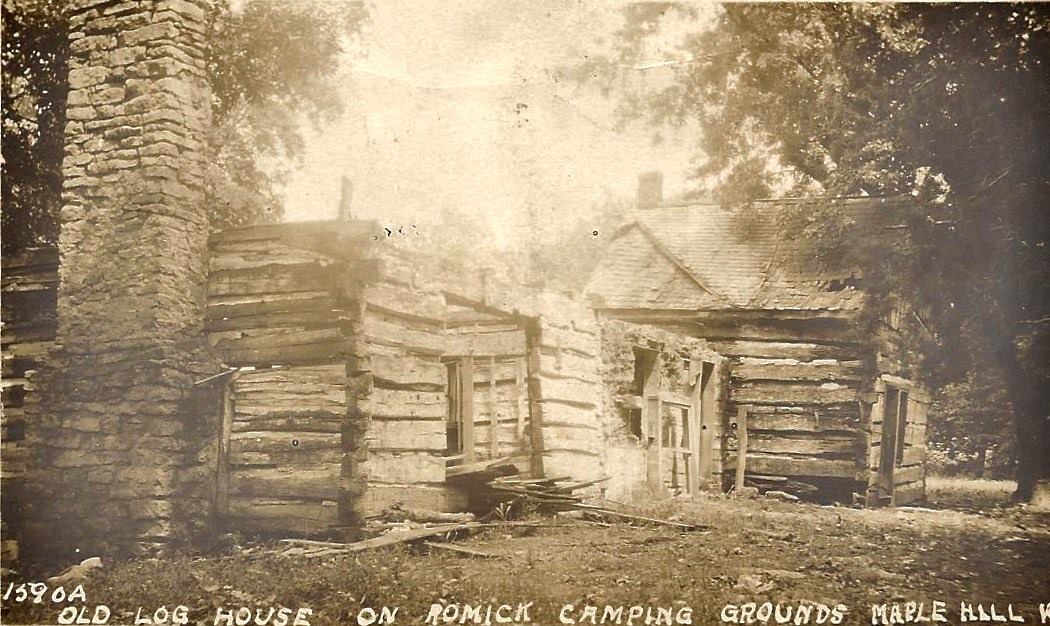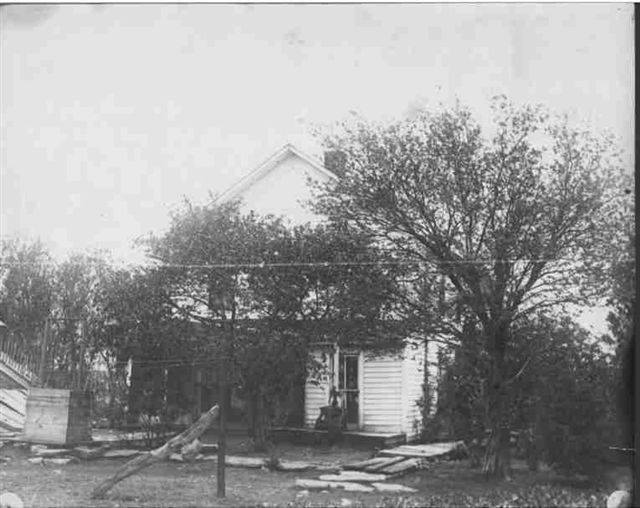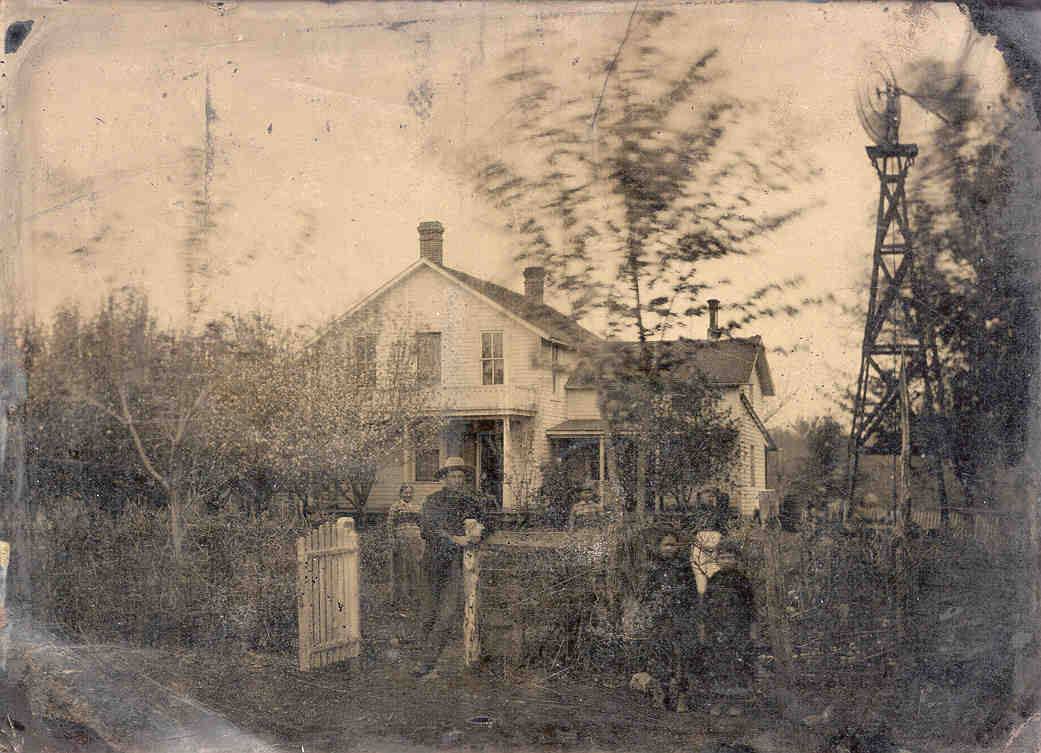1872 was a busy year for the Maple Hill area. Maple Hill Township was formed by dividing Newbury Township into two portions, with the eastern half becoming Maple Hill Township. There were 108 voters in Maple Hill Township in 1872, and the voting place was at the Rufus Waterman home. Remember, only men could vote at that time and they had to be 21-years-old and citizens of the United States. That means the population of Maple Hill Township was likey four or five times the 108 voters since there were many immigrants and women who also lived in the township.
If you’ve read previous articles, you’ll remember that Rufus Waterman married Isabella Bourassa Higathbottom and they had a log house on Mill Creek near the present bridge over Mill Creek on K-30. The house was somewhere near the Steele Romick home on the farm now owned by Greg Dieter. I’ll attach a photo of the log house and school.
That location was also where the first log school house was built. It was used by Bourassa, Waterman and Winkler children. It was later incorporated as an addition to the Waterman House and a new frame school, District 39, was built just northeast of the present town of Maple Hill. This school house has been remodeled many times but is still standing. It’s the first house on the west side of the road as you drive north out of Maple Hill on the St. Marys Road and is on the Adam’s Ranch.
I have copied the July 1872 Maple Hill News Items from the Wabaunsee County News, which will be of interest here.
“July 1, 1872 Dear Editor. With your permission, I will send a few notes from this remote and seldom mentioned corner of the county. We have been making some little progress this last spring and summer in the way of improvements, etc.
Mr. M. W. Janes has built a nice stone house, thirty by sixty feet with a basement. Also a stone fence, the best I have seen in the county. It is 30 at the base and 410 high and is faced on both sides.
Messers. [Collin} Cameron and [Gilbert] Stewart are among our most industrious citizens. They each have 100 acres of corn, a house and most all with their own hands. The last named gentleman and Mr. Janes have the only thorough bred cattle in the area.
Henry Fauerbach has the best arranged farm in the neighborhood with two hedge fences and plenty of old corn.
Mr. Edmond Beaubien has fenced and broke quite a farm this past spring and summer. If we had a few more such men, we would soon change the geography of lower Mill Creek.
Mr. Dodds of Illinois has bought 480 acres of land near Mr. [Henry] Fauerbach and has built a small stone house.
Mr. [Ruben] R. Haas had the misfortune of having his mill dam washed away in the recent high waters but his step was soon elastic again when his wife [Margaret Frigon] presented him with a fine son.
Mr. Theodore S. Bourassa and Miss Maggie Muller were married June 26, 1872. Miss Mullers father who operates the ferry across the Kaw, is rather unhappy but none-the-less we wish them luck!
Mill Creeker
July 8 I will sell at my residence, the Maple Hill Post Office, on Thursday, July 11, a large lot of cattle, horses, hogs, corn, and many farming utensils. Seventeen milk cows, eight two-year heifers, twelve steers, two yearlings, one two-year-old Durham bull, one span of horses, two colts, twenty-five hogs, one riding cultivator, three plows, one harrow, harness and 300 bushels of corn. John Winkler”
I wish I knew who “Mill Creeker” might have been. Obviously, it was someone with a good education. I would also speculate that it was most like a man since it was not proper for women to write at that time in history. My guesss would be that it was Mr. J. H. Durham a well-educated Easterner, but I do not know.
You will note that John Winkler sold his farm on the west side of K-30 near the present Mill Creek bridge, and was holding an auction to disperse his livestock and equipment. John was the great great grandfather of our friend Allan Winkler, curator of the Wabaunsee County Historical Society. John Winkler and his family moved west to Alma, where he built and operated a hotel for many years.
The M. W. Janes farm is located on both sides of the Willard/Maple Hill Road about four miles east of Maple Hill. Although some of the property has changed hands in the last few years, I know that Johnny Miller’s family owned the portion of the farm on the south side of the Willard/Maple Hill Road and the Franklin Adams family owned the river bottom portion on the north side of the road. I believe the Millers may now own that property as well. M. J. Janes was the son of Heman Janes, a lumber and oil baron from Erie, Ohio. His father had the finances to make certain that he had the very best of everything. I don’t know where the stone house is that is mentioned in the article. However, M. W. Janes built a beautiful frame mansion that had gas lights, venetian blinds and indoor bathrooms, probably one of the first in the county. Unfortunately, it burned. The huge barn that he built just south of the house, was still standing and in use the last time I drove by the property. For many years, Janes was one of the leading men of the country, active in nearly every political and social pursuit. As so often happens, he fell on hard times in the early 1890s and gradually lost his land. He was still living at the Maple Hill farm in 1905, along with three of his children, but moved to Topeka and died there. He’s buried in Topeka Cemetery.
Henry Fauerbach was one of the earliest pioneers in the Maple Hill area. He went to California seeking gold, then became a teamster. He owned several freight wagons and drove the wagons and oxen from Westport Landing (present day Kansas City) west through Kansas and Colorado with supplies. He passed through the Mill Creek Valley several times on these trips and knew exactly where he wanted to settled. After he married, he and his wife Charlotte, moved to the property on Mill Creek, about a mile from its juncture with the Kansas River, and lived under their freight wagon until a house could be built. There, they raised a large family who were prominent in Maple Hill Township for many generations and years.
Edmond Beaubien and his wife, Mary C. (Blanchette) Beaubien, moved from Illinois in 1870 and purchased a portion of the Jude W. Bourassa farm. The land straddled Mill Creek and many of us who grew up in Maple Hill, will know it as the Frank McClelland Farm, later occupied by their children Don McClelland and is sister Hattie Wilson. The Beaubiens first lived in the log Bourassa House, (not to be confused with the house pictured below) but it burned and was replaced by the home which Don and Hattie lived in. All of the lumber for the frame house was cut on the Beaubien farm at the Bourassa mill on Mill Creek. Edmund Beaubien’s health was not good when they arrived in Maple Hill and he died in 1874. His wife, Mary C. Beaubien continued to live in the new frame house and in 1887, built the Beaubien Hotel in the new town of Maple Hill. She gave her farm property to her two children and moved into Maple Hill, where she operated the hotel until her death in 1929.
I want to write more extensively about each of these families and have other photographs to share, but for today, I will quit and publish this much of the story. Enjoy!!
Photo 1: The log Bourassa-Waterman-Haas House and the log school house.
Photo 2. The Beaubien Hotel, which was directly north of the Maple
Hill Depot, in what would now be the Maple Hill City Park.
Photo 3. This is the frame house built by Mary C. Beaubien on her farm south of Maple Hill. The house was later occupied by Frank and Mattie McClelland and their family and then by Don McClelland and Hattie (McClelland) Wilson.


